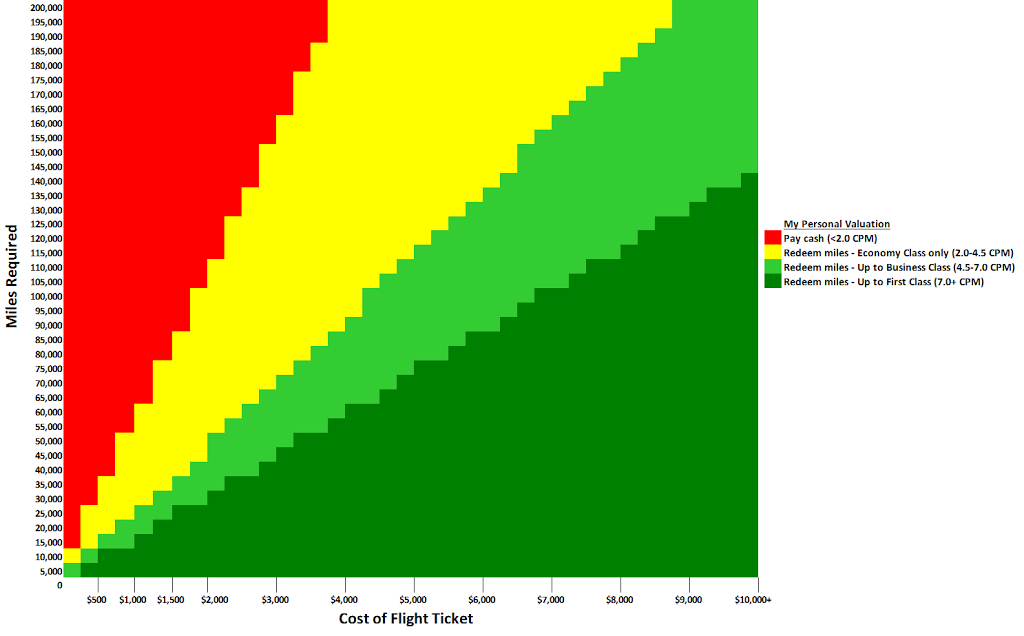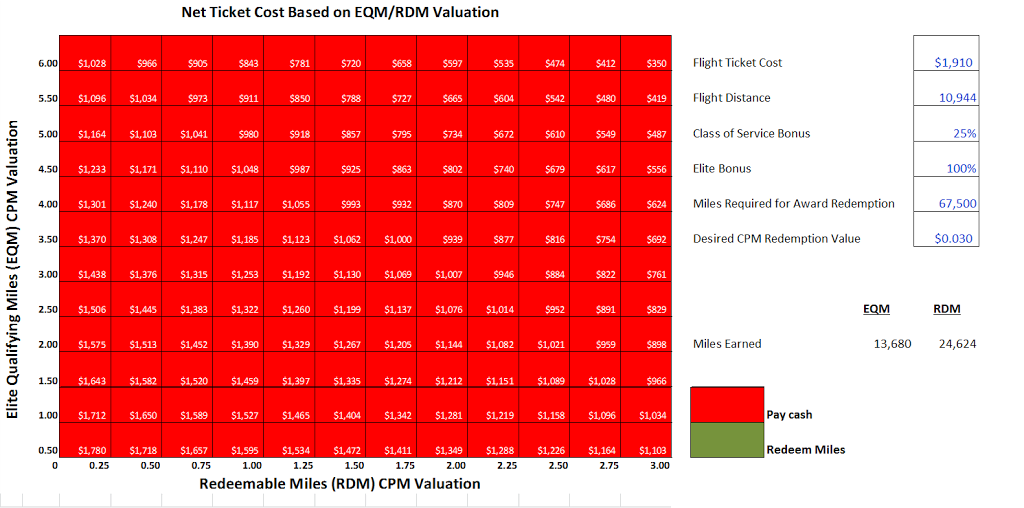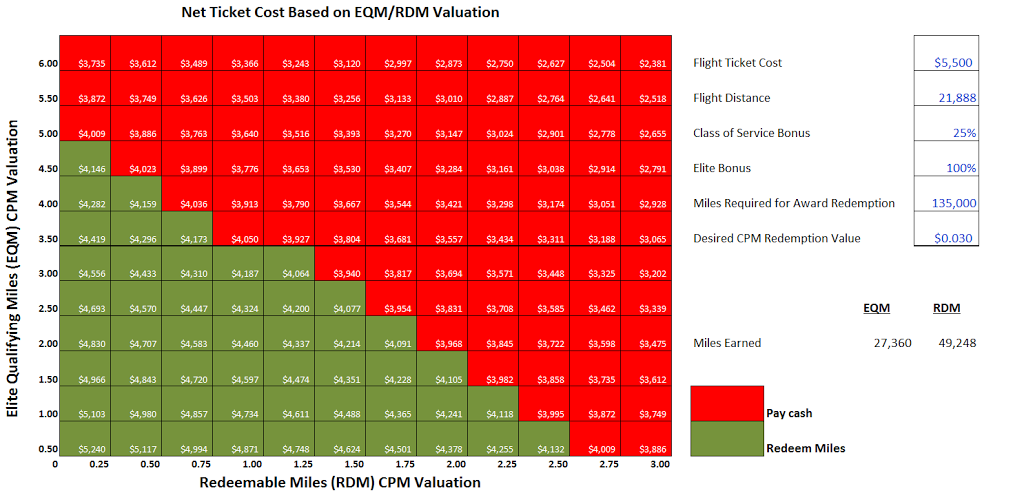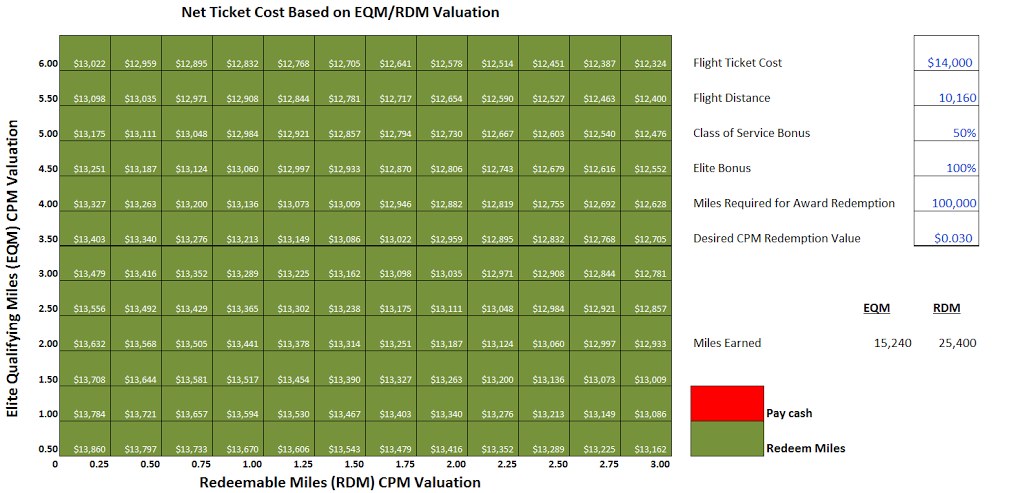Cheat Sheet For Visualizing The True Cost Of A Flight, And Whether To Purchase A Ticket Or Use Miles

Back in July, I put out my first attempt at developing a cheat sheet for visualizing the situations when it made sense to redeem miles for flights and which class to book. Since then, I’ve come across a couple situations that have me looking at this question in a slightly different way.
In my quest to re-qualify for Alaska Airlines MVP Gold status, which requires that I earn 50,000 elite qualifying miles (EQM’s), I’ve been increasingly willing to pay for tickets when the price is right, rather than redeem miles. So the question becomes, when is the price right?
What’s the net cost of an airline ticket?
At work we deal a lot with net costs, which in my case pertains to an employer’s net health care spend after accounting for the amount that is collected from employees via payroll deductions. I’m sure you all know what I’m talking about – that $50, $100, or even $500 chunk that comes out of each paycheck to pay for health insurance. If you’re providing an employer with their bottom-line costs, that money must be accounted for.
As another example, let’s say there was a membership level at Costco that gave back $10 for every $100 you spent. If I walked in this afternoon, bought $100 worth of stuff, and received a $10 credit at month’s end directly related to that purchase, then the net cost of today’s purchase wasn’t $100, it was $90.
But now, take the same scenario above, but instead of a $10 rebate you receive something without a well-defined dollar value, like raffle tickets, show tickets, or a meet and greet with a celebrity. Each and every person would place a different valuation on those items. For some those they may be worthless, others may place a value of $10, and to some they may be priceless.
And that’s the situation we find ourselves in with airline tickets, and frankly where I’m a bit surprised that there isn’t more focus on the net cost of our tickets purchases. We typically take the cost of the ticket, the flight distance, and use those numbers to calculate the cents-per-mile (CPM) cost of that ticket.
But every time you fly on a paid fare you are getting back a rebate, so to speak, in the form of elite qualifying miles and redeemable miles (RDM’s) that absolutely have a non-trivial, material value. If they didn’t, why would any of us be in this game?
What’s the value of the miles earned?
Now comes the hard part, placing a value on the EQM’s and RDM’s that are earned as part of that flight. The trouble is that each person has their own valuation of those miles, and in many cases the same exact flight will even yield different earnings based on the fare class of the ticket as well as your level of status with the airline.
It’s impossible to place an exact value on miles, so I took a different approach. Instead, I’m providing a broad scale that let’s you figure out the correct answer for yourself, based on your own valuations.
In the graph below, I’m showing a recent example from my own personal experience. For my return flight from Dubai, I had my choice of booking a Business Class ticket home on Cathay Pacific with 67,500 American Airlines miles or $1,910. Crunching the numbers, it’s roughly a 2.8 CPM redemption value. But that’s without taking into account the EQM’s and RDM’s that would be earned.
The chart below shows what the net cost of that ticket would be, using a range of different valuations for both EQM and RDM’s. The calculations take into account both the Class of Service and Elite bonuses, as well as the number of miles that would be required for an equivalent award redemption and the desired or target CPM for an award booking.
To me, the true comparison of when to book an award ticket vs. purchasing a flight must take the net cost into account. For example, if I valued EQM’s and RDM’s at 1.5 CPM each, then the net cost of my ticket drops from $1,910 to $1,335. And if my valuations of EQM’s and RDM’s are 3.0 CPM and 2.0 CPM, respectively, the net cost of my ticket drops even further to $1,007.
When to pay cash vs. redeem miles
I’ve also layered in the colors, which signal when you should pay cash vs. redeem miles for a flight, based on the number of miles required and your desired CPM redemption value. In the example above, a redemption of 67,500 miles with a desired CPM redemption value of 3.0 CPM means that I should purchase all tickets with a net cost below $2,025. Since this was such a good deal, even if I placed no value on the miles earned I’d still be better off paying cash for the ticket than redeeming miles.
Let’s look at a more typical example. For a round-trip Business Class ticket from LAX to DXB, that ticket can often cost upwards of $5,500. Using those figures, the chart now shows based on your personal valuation of the miles, when you should pay cash vs. redeem miles.
Now keep in mind, in no way am I suggesting that you should be shelling out $5,500 for a Business Class ticket in all of the cases above shown in red. Instead, this will show you purely based on the math of what you want to get out of your miles, when the trade-off between spending vs. earning miles makes sense.
And here’s a typical example from my recent Alaska Airlines redemption for 100,000 miles to fly First Class from San Francisco to Seychelles, via Dubai. The round-trip cost of that same ticket comes in at a whopping $28,000, of which I’ll use half as the one-way cost even though it doesn’t always work out like that. As you can imagine, green all the way around in this scenario.
Negative net costs – making money by flying!
As an interesting note, let’s also look at a typical mileage run situation. For example, let’s say that you were able to snag a domestic fare for $300 that took you all across the US. With a convoluted routing that picked up some 500-mile minimums from short segments, a really good routing may yield up to 7,500 miles.
In this scenario, once you get above the 1.5 CPM valuations for EQM’s and RDM’s, you’re actually in a situation where the net cost of your ticket is negative. In other words, you’re making money by flying!
Well not literally, as the miles you’re earning have no cash value. But this actually makes perfect sense – the whole reason we scour the forums for the cheapest, craziest, most convoluted mileage runs is that the value you’re receiving by suffering through those flights, which ultimately comes in the form of elite status and miles to use for future bookings, outweighs the cash outlay.
As I mentioned at the beginning, we will never get to the point where everyone places the same, singular valuation on airline miles. The key is having the sensitivity analysis built-in, so that each person can see where they fit in along the valuation spectrum, and use that information to inform the best decision for themselves.
So happy mileage running to all, and I’d love to hear your feedback. I’m also happy to share the Excel tool with anyone that is interested.




Nice analysis! I agree with you we should take the cost of EQM into account. However, if we want to compare the “true” cost of using cash vs. redeeming points, there are really unlimited number factors that can be considered, for example, time. You probably spent quite bit of time crunching these numbers. Other major factors I consider are liquidity and risk of devaluation. Points and cash are both assets. When you use cash instead of points because cash is worth less based on your analysis, you are trading your cash asset for the points asset. However, points have much less liquidity than cash and also have the risk of devaluation. As long as the value of points needed is not ridiculously higher than cash price, I usually just use points. Just my 2 cents.
Great points – there really are an unlimited number of factors at play. When deciding between the same flight and bookings with miles vs. points, time isn’t necessarily a factor, but it certainly is when deciding whether or not to mileage run.
And you’re completely right about the opportunity cost of spending cash and having it earn interest, vs. “investing” it in a non-interest earning account that runs the risk of devaluation at any moment.
Maybe we need to go a step further, and look at the NPV of earning miles. Maybe someone out there much smarter than me can come up with a reasonable discount rate to use!
It’s fascinating how somebody out there invented the whole concept of miles and points and managed to maintain a currency system that is entirely unregulated. I’m going to take this lesson and apply it to my bubble tea business… sure you can get a free drink for 10 stamps, but why stop there? Collect 100 and get a free foot massage! 200 and three hours of free karaoke! Those with 50 or more stamps in balance get to cut the line for a whole year (because my service is freaking slow). Stamps are transferable to the hot pot restaurant next door, but hurry up because a free drink will cost 12 stamps starting next Monday!
Don’t forget that in 10-20 years you’ll go bankrupt, only to merge with Terence’s bubble tea store!
Very nice analysis and tool! It’s nice that it’s not a fixed CPM but rather a range for everyone’s own valuation like you mentioned. Do you mind sharing this with me?
Ash – thanks! I’d be happy to email this to you, where should I send it?